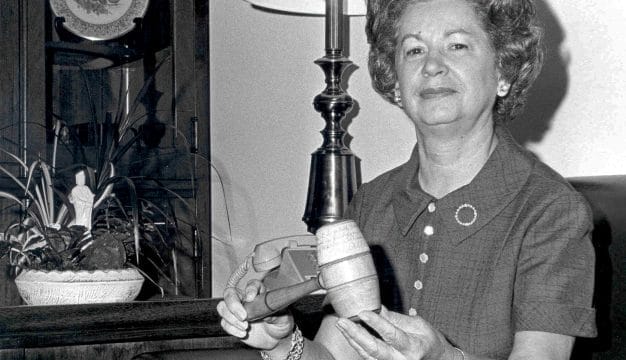Thirty-first "Dixie" Division
From its inception, the Thirty-first Division has had a continuous link with the state of Alabama. It was created as a National Guard division during World War I and survived in that capacity until the post-Korean War era. The World War II period saw the most active role for the Thirty-first, as it served first to train personnel and was then engaged in the Pacific Theater of Operations. The division’s insignia is back-to-back red double Ds on a white field circled in red.
In early August 1917, the federal government called the entire Alabama National Guard to active duty for service in World War I. Of the 5,025 officers and men, 3,677 became part of the newly organized 167th Infantry, Forty-second
 Thirty-first Division Insignia
Division. The remaining 1,348 officers and men became the core of Alabama troops associated with the Thirty-first Infantry Division. This division, composed of National Guard units from all over Alabama, as well as Georgia and Florida, became known as the “Dixie” Division, with the motto “It shall be done.” In 1917 and 1918, Camp Joseph Wheeler, near Macon, Georgia, was the training camp for the Thirty-first, which reached Brest, France, only in October 1918. Most of the men who saw action were sent to other divisions as replacements. It was demobilized in January 1919 at Camp Gordon, Georgia.
Thirty-first Division Insignia
Division. The remaining 1,348 officers and men became the core of Alabama troops associated with the Thirty-first Infantry Division. This division, composed of National Guard units from all over Alabama, as well as Georgia and Florida, became known as the “Dixie” Division, with the motto “It shall be done.” In 1917 and 1918, Camp Joseph Wheeler, near Macon, Georgia, was the training camp for the Thirty-first, which reached Brest, France, only in October 1918. Most of the men who saw action were sent to other divisions as replacements. It was demobilized in January 1919 at Camp Gordon, Georgia.
The unit was reactivated in 1923, again as a National Guard division with southern ties, as units from Alabama, Florida, Mississippi, and Louisiana joined to form this version of the Dixie Division. Alabama’s 167th Infantry Regiment, which in World War I had been part of the Forty-second Division, now became one of the three infantry regiments of the Thirty-first, the others being the 155th from Mississippi and the 124th from Florida. The unit participated in regular training activities, which increased in intensity and importance beginning about 1938 in response to German and Japanese aggression and militarization.
Responding to war in Europe and rising tensions in Asia, Pres. Franklin D. Roosevelt ordered the Thirty-first into active service on November 25, 1940. Division commander Maj. Gen. John C. Persons then established temporary headquarters in Birmingham until construction was completed at Camp Blanding in Florida. As the division began its training, recruits from other parts of the United States joined the division, somewhat diluting the “Dixie” make-up. Yet, the nickname and the southern states’ influence and their National Guard elements remained. From January 1941 until March 1944, the Thirty-first served as a training division. Officers and enlisted men rotated in and out after completing training for both the European and Pacific theaters. The unit completed training activities in several states, including Florida, North Carolina, Texas, Louisiana, Mississippi, West Virginia, Virginia.
Training in the Deep South’s summer heat and humidity proved beneficial as the Thirty-first received orders for deployment in the South Pacific in 1944. The division left the United States in March 1944, arriving the next month on the island of New Guinea, just north of Australia, to fight under the command of Gen. Douglas MacArthur. The 124th Infantry Combat Team went to Aitape, and the remainder went to Toem and Sarmi and nearby Wadke Island. In these locales on New Guinea’s northern coast, the men of the Thirty-first engaged in combat against the Japanese from mid-July to mid-September 1944.
In mid-September, the division moved northwest to the Netherlands East Indies island of Morotai, which was an important staging area with a primitive airstrip. Several of the Philippine Islands were reachable by air from Morotai, and thus the island was valuable to Allied forces preparing to liberate the Philippines from Japanese occupation. The troops landed unopposed on the relatively lightly defended island on September 15, 1944, but endured nightly Japanese bombing raids. Aided by air support from nearby naval forces, the Thirty-first and other units prevented the Japanese from effectively reinforcing Morotai from the Japanese base on nearby Halmahera.
Meanwhile, the Second Battalion of the 167th Infantry seized Mapia Island. Other elements of the 167th Infantry took control of a base at Sansapor on the northwestern tip of New Guinea. In December, a battalion of the 167th assisted in eliminating final Japanese resistance on Morotai. The island was secured by January 10, 1945.
The Thirty-first remained at Morotai and Sansapor until April 1945, when the men departed for Mindanao Island in the Philippines. There, the Thirty-first encountered fierce Japanese resistance and heavier fighting than it had experienced on Morotai. The division’s action on Mindanao concentrated along the Sayre Highway and in an area known as Colgan’s Woods. The 167th Infantry, in the Davao and Sarangani Bay areas of Mindanao, was fighting along the Kibawe-Talamo trail, also in difficult conditions and harsh terrain. The Thirty-first remained in this region until the end of the war. It returned to the United States to Camp Stoneman, California, and was deactivated in December 1945, returning to National Guard status.
During the Korean War, the Thirty-first Division was again federally activated, with orders to provide training for troops going to Korea. Individual troops from the Thirty-first went to Korea as replacements from 1951 to 1953, when the division was ordered to prepare for deployment. The ceasefire in July 1953 negated the necessity for its deployment, however, and in 1954 the Dixie Division was deactivated and returned once again to National Guard status in Alabama and Mississippi.
The divisional designation for the Thirty-first disappeared in 1968, but the flag of the Thirty-first and the numerical designation were given to the Thirty-first Brigade, Thirtieth Armored Division, Alabama Army National Guard, until 1974, when the Thirtieth was deactivated. The Thirty-first Brigade became the Thirty-first Separate Armored Brigade, headquartered in Tuscaloosa. In September 2002, following deactivation of the Thirty-first Separate Armored Brigade, the Thirty-first Chemical Brigade, headquartered in Northport, Tuscaloosa County, received the designation associated with the former “Dixie” Division.
Additional Resources
“Dixie Newsletter.” 31st Infantry (Dixie) Division Newsletter, Jackson, Mississippi, December 2008, March and June 2009.
Frazer, Nimrod T. Send the Alabamians!: World War I Fighters in the Rainbow Division. Tuscaloosa: University of Alabama Press, 2014.
Merritt, Gus. 31st Infantry “Dixie” Division: It Shall Be Done. Paducah, Ky.: Turner Publishing, 1995.
Truss, Ruth Smith. “The Alabama National Guard, 1900 to 1920.” Ph.D. diss., University of Alabama, 1992.



